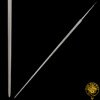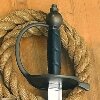|
|
|
 |
|
| Hanwei Practical Basket Hilt Backsword (SH2075) |
Points: 15

|
The Practical Mortuary Hilt and Practical Basket-Hilt swords are built for the re-enactor. The baskets are identical to the edged versions, but the blades are unsharpened, with 1/16" safety edges and rounded tips, complying with the combat rules of many re-enactment societies. The blades are crafted in 1065 high-carbon steel, hardened to 50HRC, which reduces edge-notching to acceptable levels while providing resilience and protection against brittleness. The scabbards are finished in matte black, ready for owner customization if desired.
|
|
|
|
|
|
 |
|
| Hanwei Practical Basket Hilt Broadsword (SH2059) |
Points: 15
|
The Practical Mortuary Hilt and Practical Basket-Hilt swords are built for the re-enactor. The baskets are identical to the edged versions, but the blades are unsharpened, with 1/16" safety edges and rounded tips, complying with the combat rules of many re-enactment societies. The blades are crafted in 1065 high-carbon steel, hardened to 50HRC, which reduces edge-notching to acceptable levels while providing resilience and protection against brittleness. The scabbards are finished in matte black, ready for owner customization if desired.
|
|
|
|
|
|
 |
|
| Hanwei Renaissance Style Swept Hilt Rapier (SH1024) |
Points: 12

|
Our Renaissance-style Swept Hilt Rapiers trace their origins to early 17th century Europe, where swordplay with the Rapier was considered an essential part of a gentleman's education and was often used in resolving gentlemanly disagreements. Blades generally originated in one of the blade making centers such as Toledo or Solingen, but many differences in styling and hilt materials resulted from the local manufacture of hilts all over Europe. The Main Gauche, or left hand dagger, was often used with the rapier, providing an added dimension in both offense and defense, and the "Schools of Fence" which proliferated in Europe during this period taught the use of the two weapons in combination. The Main Gauche would often match the Rapier in styling, while incorporating features which maximized the effectiveness of the piece.
|
|
|
|
|
|
 |
|
| Hanwei Main Gauche - Wood Grip (matches SH1024) (SH2198) |
Points: 10
|
Our Renaissance-style Swept Hilt Rapiers trace their origins to early 17th century Europe, where swordplay with the Rapier was considered an essential part of a gentleman's education and was often used in resolving gentlemanly disagreements. Blades generally originated in one of the blade making centers such as Toledo or Solingen, but many differences in styling and hilt materials resulted from the local manufacture of hilts all over Europe. The Main Gauche, or left hand dagger, was often used with the rapier, providing an added dimension in both offense and defense, and the "Schools of Fence" which proliferated in Europe during this period taught the use of the two weapons in combination. The Main Gauche would often match the Rapier in styling, while incorporating features which maximized the effectiveness of the piece.
|
|
|
|
|
|
 |
|
| Hanwei Main Gauche (matches SH1092) (SH2197) |
Points: 8
|
Our Renaissance-style Swept Hilt Rapiers trace their origins to early 17th century Europe, where swordplay with the Rapier was considered an essential part of a gentleman's education and was often used in resolving gentlemanly disagreements. Blades generally originated in one of the blade making centers such as Toledo or Solingen, but many differences in styling and hilt materials resulted from the local manufacture of hilts all over Europe. The Main Gauche, or left hand dagger, was often used with the rapier, providing an added dimension in both offense and defense, and the "Schools of Fence" which proliferated in Europe during this period taught the use of the two weapons in combination. The Main Gauche would often match the Rapier in styling, while incorporating features which maximized the effectiveness of the piece.
|
|
|
|
|
|
 |
|
| Hanwei Live Rapier Blade (OH2327) |
Points: 4
|
Live Rapier Blade for rapiers: Renaissance Style Swept Hilt Rapier (SH1024), Bone Handled Swept Hilt Rapier (SH1092), Solingen Rapier (SH2205, SH2205N), Torino Rapier (SH2204, SH2204N), Gustav Rapier (SH2206, SH2206N).
|
|
|
|
|
|
 |
|
| Hanwei Practical Mortuary Hilt Sword (SH2076) |
Points: 13

|
The Practical Mortuary Hilt Sword (SH2076) is built for the re-enactor. The basket is identical to that of the SH2004 but the blade is unsharpened, with 1/16" edged and a rounded tip, complying with the combat rules of many re-enactment societies.
|
|
|
|
|
|
 |
|
| Hanwei Practical Side Sword (SH2279) |
Points: 15
|
The Practical Side Sword (SH2279) uses the same hilt as the sharp version(SH2203), but carries a sparring blade designed for safety. Side sword sparring, in both sword & buckler and sword & dagger modes is becoming increasingly popular with many proponents among the ranks of the various Renaissance societies.
The Side Sword was a military sword of the 16th and 17th century Renaissance period that also achieved popularity among civilians, due to its relatively light weight and quickness. It also had an advantage over its contemporary, the rapier, in having the ability to cut efficiently as well as thrust. Side swords were often the weapon of choice for sword and buckler fighting. Our side sword, based on a German original, is a beautifully proportioned piece that balances very well. The "swept" hilt affords excellent hand protection and the blade geometry makes for outstanding performance in both the cut and the thrust. Includes black leather scabbard.
|
|
|
|
|
|
 |
|
| Practical Scramasax (SH2297) |
Points: 6
|
The Practical Scramasax has been produced in response to many requests from Viking re-enactors. Its 12" blade, with a rounded tip and 1/16" wide edge, make it an ideal secondary weapon. A horizontal-carry scabbard is provided.
|
|
|
|
|
|
 |
|
| Pirate Captains Hanger Sword (500968) |
Points: 14

|
Pirate Captain's Hanger is made of beautiful antiqued brass and has a steel hilt. The fully tempered high carbon steel blade is worth its salt against any sea beast or while swarming the side of a galley. Your pirate captain’s costume is incomplete without this hanger. Made by Windlass Steelcrafts.
|
|
|
|
|
|
|
|
Tags:
sword, swords, medieval sword, single hand sword, one hand sword, hand and half sword, hand and half swords, double handed sword, two handed sword, double handed swords, two handed swords, medieval swords, viking sword, viking swords, forged sword, forged swords, tempered sword, tempered swords, fighting sword, swords for fighting,
|













